
This new report by the International Telecommunication Union (ITU) focuses on how the telecommunication reform programmes of the last decade are shaping the market of the coming decade.
No region of the world has embraced the privatization of telecommunications as enthusiastically as Latin America. Of 89 incumbent public telephone operators worldwide that had been privatized by the end of 1999, one quarter were in the Americas region. Even more impressive is the degree of private participation in the sector. While more than two-thirds of the countries of the Americas region have either partially or fully privatized their telecommunication companies, in other regions like Africa and the Arab States, this percentage drops to 28 and 33 per cent respectively.

So begins the Executive Summary of the ITU's most recent regional indicators report, Americas Telecommunication Indicators 2000. The report was published on the occasion of the ITU TELECOM AMERICAS 2000 Exhibition and Forum, held in Rio de Janeiro in April of this year. The report reviews telecommunication developments in the emerging economies of the western hemisphere.
Mobile communications in Latin America has grown strongly over the last decade, rising from just 100 000 subscribers in 1990 to over 39 million in 1999. The number of new mobile users has exceeded new fixed telephone subscribers every year since 1997. Today, one in every four telephone users in the region depends on a mobile phone. In Paraguay and Venezuela, there are more mobile subscribers than traditional fixed telephone line customers. The rapid rise in mobile subscriptions is attributed to private ownership and competition, the implementation of calling party pays and the introduction of pre-paid cards.
Growth of the Internet in Latin America has been as equally, if not more, impressive than mobile. The number of Internet host computers grew faster there than in any other region of the world in 1999 and reached a significant milestone, surpassing one million during that year. The number of users is estimated at 9 million. Falling prices have contributed to increased Internet access in Latin America. Equally important has been the rise of Spanish Web content, the world's fourth largest linguistic group with some 300 million speakers.
Americas Telecommunication Indicators 2000 contains 140 pages of text, reference information, statistics and directory of telecommunication operators in the region and is published in English and Spanish. Information about ordering the publication, including free access to the Executive Summary, is available at http://www.itu.int/ti/publications/americas/2000/index.htm .

The world market for telecommunications (services and equipment) doubled between 1990 and 1999 and was worth over USD 1000 billion in 1999. The services segment accounted for almost three quarters of global telecommunication revenues or some USD 800 million.
Mobile communications is driving growth and now accounts for 24 per cent of the total service revenues, up from just 3 per cent in 1990. Although revenues from the fixed telephone network continue to dominate the total market, its share has fallen significantly, from 90 per cent in 1990 to 61 per cent in 1999.
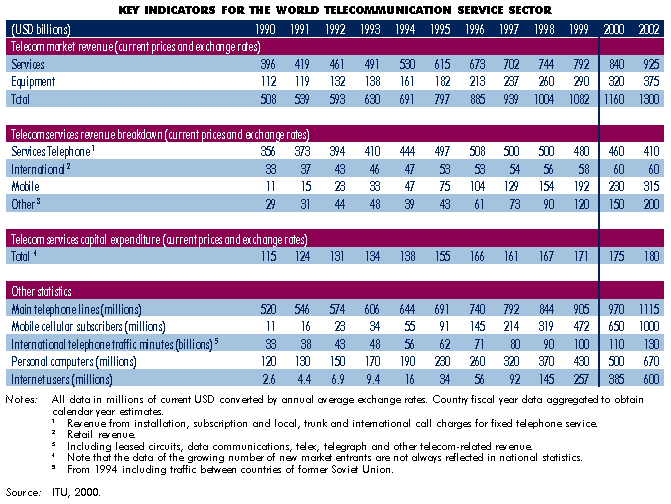
Electronic messages sent by mobile telephones are exploding in Europe. The GSM digital mobile system, the standard in Europe and also used in some 100 countries around the world, supports text exchange (up to 160 characters) between mobile handsets through the short message service (SMS) feature.
The GSM Association http://www.gsmworld.com/news/press_releases_55.html announced that "G-Mails" (GSM-Mail or SMS) totalled five billion around the world in the month of March 2000, with European nations accounting for the bulk of the mobile text traffic. The GSM Association predicts that 10 billion messages a month will be transmitted by year-end 2000.
In a recent report, Cellular Mobile Pricing Structures and Trends, http://www.oecd.org/dsti/sti/it/cm/prod/ e_99-11.htm the Organisation for Economic Co-operation and Development (OECD), a grouping of the world's wealthiest economies, has reviewed and benchmarked SMS in its member countries. Most operators charge for each SMS message sent. The OECD found that the average price of an SMS message in the OECD is 16 US cents with the lowest being 3 cents and highest 25 cents.
Another interesting finding of the OECD report is the difference in SMS usage between postpay and prepay users with the latter using it significantly more. For example, the prepay customers of the UK mobile operator Vodafone send 8 times as many SMS messages a month as postpaid clients. This is because the heaviest SMS users tend to be young and thus more likely to not qualify for postpay service. This is con firmed by recent research from Amárach http://www.amarach.com/news/press7.htm in Ireland showing that 85 per cent of mobile users aged 15-19 use SMS compared to 40 per cent for those aged 35-49. The research also found that one third of those aged 15-24 years old sent over 20 SMS messages a week.
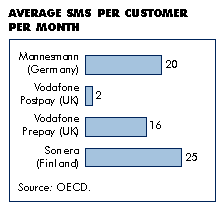
The global boom in mobile cellular communications has been truly astounding. At the end of 1999, there were more than 450 million subscribers around the world, up from just 11 million in 1990. That is a compound annual growth rate of more than 50 per cent per year. In other words, the number of mobile subscribers worldwide has been doubling every 20 months since the start of the decade.
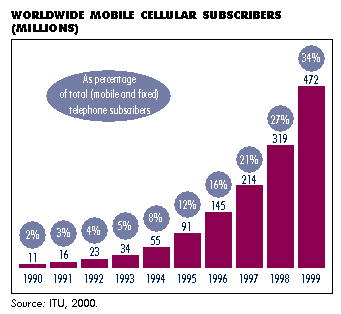
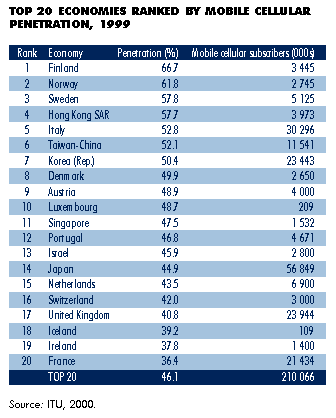
Finland made headlines at the end of 1998 when it became the first nation to top 50 per cent mobile penetration. Along with Cambodia, it was one of only two countries in the world where the number of mobile subscribers surpassed that of fixed-line subscribers.
At the end of 1999, seven more countries joined the club. The most recent members are the Republic of the Congo (Brazzaville) and Hong Kong Special Administrative Region (SAR) where mobile surpassed fixed in the first half of 2000. The ITU forecasts that by the middle of this decade, there will be more cellular subscribers worldwide than fixed-line subscribers.
The mobile boom could be far from over. For example, in Nordic nations, where every other person now has a mobile phone, the cellular penetration rate is forecast to top 100 per cent. It is likely that other developed countries will follow this pattern. Meanwhile, in emerging economies, there is considerable pent-up demand for telecommunications. Mobile is a perfect fit since wireless networks can be installed quickly and pre-paid provides rapid access for those who would not normally qualify for a subscription service.
For more information on mobile cellular, see http://www.itu.int/ti/publications/wtdr_99/wtdr99.htm.
Economies with more mobile than fixed telephone subscribers at end of 1999
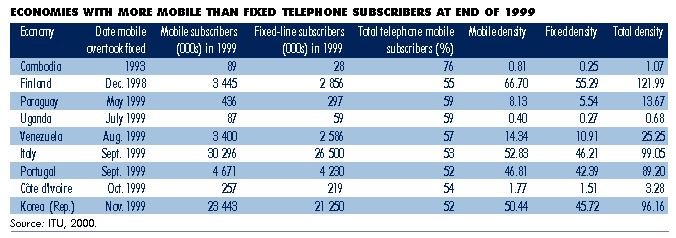
 The Republic of Uganda,
covering an area of 235 885 km, is an agricultural country with a population of about 22 million. Over 85 per cent of
its citizens live in rural areas; the capital Kampala has almost 900 000 inhabitants but accounts for just 4 per cent of
the country's population. Although land-locked, Uganda is in the Great Lakes region of eastern Africa with some 15 per
cent of its area consisting of water. A significant portion of Lake Victoria, the largest fresh water lake in Africa and
source of the river Nile, is found in Uganda territory.
The Republic of Uganda,
covering an area of 235 885 km, is an agricultural country with a population of about 22 million. Over 85 per cent of
its citizens live in rural areas; the capital Kampala has almost 900 000 inhabitants but accounts for just 4 per cent of
the country's population. Although land-locked, Uganda is in the Great Lakes region of eastern Africa with some 15 per
cent of its area consisting of water. A significant portion of Lake Victoria, the largest fresh water lake in Africa and
source of the river Nile, is found in Uganda territory.
Uganda's Gross Domestic Product (GDP) per capita is less than USD 300, making it a least developed country. It has historically had one of the lowest levels of telephone penetration in the world. However, government initiatives to boost the economy through privatization and foreign investment are starting to pay off. Nowhere is this more evident than the telecommunications sector, which is now one of the most liberal in Africa. Steps taken over the last five years to foster growth in telecommunications include:
The results of these changes have been dramatic. Uganda's overall telephone density tripled between 1995 and 1999 rising from 0.21 telephone subscribers per 100 people to 0.67. This rapid growth is a direct result of MTN's entry into the market. Although MTN full ser vice licence allows it to offer all telecommunication services including fixed telephony, it has focused on mobile. One reason is that wireless networks are quick to install. Another is the use of prepaid cards since most Ugandans would not meet the financial criteria for a subscription-based service.
In a little over one year, MTN emerged as the largest network operator in Uganda surpassing not only CelTel but also the incumbent, UTL, in terms of number of clients. In July 1999, Uganda became the first African country and only one of a dozen in the world where there were more mobile than fixed telephone customers. MTN has not rested on its laurels. It has been aggressive in expanding the network into what Ugandans refer to as "up-country", that is the rural part of the nation. Over 50 per cent of the population is now covered By mobile cellular and some 40 towns have service. What is remarkable is that the number of mobile subscribers widely exceeds earlier forecasts of a potential mobile market of some 10 000! The planned entry of UTL into the mobile market should further spur growth with some estimates putting the potential mobile client base at half a million.
The Internet market is also liberalized in Uganda. There is no limit on the number of Internet Service Provider (ISP) licences. Furthermore, ISPs can provide their own national and international infrastructure. Eight ISP licences had been issued as of February 2000. There are some 4000 Internet subscribers and an estimated 25 000 users in the country. Demand is high as evidenced by an explosion of cybercafés in Kampala over the last year. There is considerable scope to expand Internet usage in the country since almost all users are currently in Kampala. Furthermore, ISP charges of USD 50 a month for unlimited access are relatively high compared to income especially considering that telephone usage charges must be added to this.
Uganda is one of the countries participating in the ITU Internet Case Studies through its Ministry of Works, Transport and Communications. For more information on the case studies, please visit the website at www.itu.int/ti/casestudies.
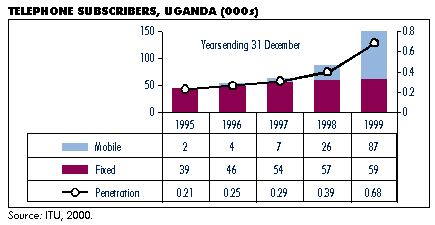
|
For more information or comments on the UPDATE, please contact: ITU/BDT, Telecommunication Data and Statistics, Place des Nations, CH-1211, Geneva 20 (Switzerland). Tel.: +41 22 730 6090. Fax: +41 22 730 6449. E-mail: indicators@itu.int |